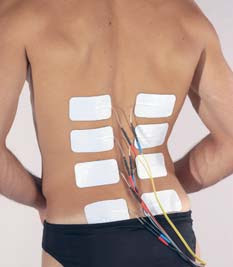請在這裡輸入標題
處理痠痛的方法有許多,電療是目前在運動中心、防護室、復健科、物理治療診所、乃至於一般居家都在使用的方法。如果注射生理食鹽水是住院的必然儀式,那麼電療幾乎是復健科醫師、物理治療師給予痠痛求診民眾的標準處置。然而,英國國家健康與照顧研究院 (The National Institute for Health and Care. Excellence, NICE) 對於腰部痠痛的治療指導方針裡明白寫著 [1]:
1.2.10 Do not offer percutaneous electrical nerve stimulation (PENS) for managing low back pain with or without sciatica.
1.2.11 Do not offer transcutaneous electrical nerve stimulation (TENS) for managing low back pain with or without sciatica.
意思是,無論有沒有坐骨神經痛,都不要用電療來控制腰痛。英國的醫學指導方針,似乎與台灣的復健科、物理治療科的標準處置互相抵觸。我們要追問的是:有充分的醫學證據支持以電療處理痠痛嗎?本文將為讀者整理有關電療在痠痛方面的醫學研究。
大綱
以下是為了能夠滿足段落所需的長度而定義的無意義內文,請自行參酌編排。
電療用於醫治疾病和止痛
電療的歷史最早可以追溯到 1767 年倫敦的醫院 [2],至今已成為西方醫學承認治療疾病的方法之一。美國物理治療協會將電療應用於止痛、治療神經肌肉功能障礙、幫助組織修復…等等 [3]。電療亦應用於腦部神經受損的疾病,例如帕金森氏症。對於傷口,電療能促進蛋白質合成使傷口癒合 [4]。雖然療效的證據不夠充分,但電療已廣泛應用於醫治疾病 [5]。值得注意的是,電療在醫療上被用於止痛,卻不被西方醫學用於療癒痠痛。

電療用於痠痛被證實無效
電療對於痠痛的作用,直白地說就是沒有療效 [6-8]。即便有些研究宣稱電療能治癒疼痛,但這些研究數據都過於微弱與粗糙 [9-13]。電療不僅對於延遲性肌肉痠痛無效,亦無助於運動後的狀態恢復 [14-15]。因此大家應該對電療有正確的觀念:電療雖然是西方醫學體系的一環,但是醫治疾病不等於解決痠痛。
接受電療之前千萬要知道它的風險。因為它對於疼痛完全沒有治療作用,純粹就是止痛,也就是用電刺激的感覺替代疼痛感,但是疼痛的成因仍在。一直止痛卻沒解決問題成因,最後將造成更嚴重的後果。例如腰痛,也許只是深層肌肉痙攣造成腰部疼痛,只要將深層肌肉放鬆即可解決問題。但若以電療止痛,則一段時間後肌肉將可能拉扯腰椎引發椎間盤突出,這時,電療不僅無法將電力送到腰椎,更不可能用電將椎間盤推回去。所以英國 NICE 直接在腰部痠痛的治療指導方針裡明白地否決電療。
解決痠痛的指導方針
除了電療,還有許多被 NICE 列為不應該用於腰痛的項目,如照 X 光片、做 MRI、牽引、超音波等。治療腰痛,NICE 的指導寫著:
1.2.7 Consider manual therapy (spinal manipulation, mobilisation or soft tissue techniques such as massage) for managing low back pain with or without sciatica, but only as part of a treatment package including exercise, with or without psychological therapy.
意思是說,建議可用按摩與運動來治療腰痛。研究證據顯示,按摩不僅比電療對腰痛還有療效,對於膝蓋關節的問題,也是按摩比電療還有效 [16]。多年來,世界各國的證據顯示,按摩能加速解決痠痛、消除疲勞,在運動痠痛方面有確實的療效 [17-24]。按摩不是醫療行為,更非醫療院所的服務項目,但卻是被證實對痠痛有效的方法。醫生與醫事人員的專長在於醫治疾病,所以,請讓醫治疾病歸醫療專業,痠痛歸於按摩專業。
結論
電療是醫治疾病的一種方式,主要應用於促進組織修復、治療神經障礙方面的疾病。對於痠痛,電療只有止痛效果,不斷止痛可能讓身體累積出更大的傷害。根據研究結果,建議痠痛時不應該採用電療處理,按摩才有確實的療效。
即時獲取本站最新消息與 Dr. 李侑青交流互動,請按讚追蹤粉絲頁喔 ➝
參考文獻
[8] S. Milne et al., “Transcutaneous electrical nerve stimulation (TENS) for chronic low back pain,” Cochrane Database of Systematic Reviews, 2001.
[9] K. E. Nnoaham and J. Kumbang, “Transcutaneous electrical nerve stimulation (TENS) for chronic pain,” Cochrane Database of Systematic Reviews, 2008.
[10] A. Khadilkar et al., “Transcutaneous electrical nerve stimulation (TENS) versus placebo for chronic low-back pain,” Cochrane Database of Systematic Reviews, 2008.
[11] D. M. Walsh et al., “Transcutaneous electrical nerve stimulation for acute pain,” Cochrane Database of Systematic Reviews. 2009.
[12] L. X. Chen et al., “Transcutaneous Electrical Nerve Stimulation in Patients with Knee Osteoarthritis: Evidence from Randomized Controlled Trials,” The Clinical Journal of Pain, vol. 32, no. 2, pp. 146-154, 2016.
[13] F. Desmeules et al., “Efficacy of transcutaneous electrical nerve stimulation for rotator cuff tendinopathy: a systematic review,” Physiotherapy, vol. 102, no. 1, pp. 41-49, 2016.
[14] J. K. Malone, C. Blake, and B. M. Caulfield, “Neuromuscular electrical stimulation: no enhancement of recovery from maximal exercise,” International Journal of Sports Physiology and Performance, vol. 9, no. 5, pp. 791-797, 2014.
[15] J. K. Malone, C. Blake, and B. M. Caulfield, “Neuromuscular electrical stimulation during recovery from exercise: a systematic review,” The Journal of Strength and Conditioning Research, vol. 28, no. 9, pp. 2478-2506, 2014.
[16] S. S. Ali et al., “Comparing the effects of manual therapy versus electrophysical agents in the management of knee osteoarthritis,” Pakistan Journal of Pharmaceutical Sciences, vol. 27, no. 4, pp. 1103-1106, 2014.
[17] E. Ernst, “Does post-exercise massage treatment reduce delayed onset muscle soreness? A systematic review,” British Journal of Sports Medicine, vol. 32, no. 3, pp. 212-214, 1998.
[18] P. Khamwong et al., “Prophylactic Effects of Sauna on Delayed-Onset Muscle Soreness of the Wrist Extensors,” Asian Journal of Sports Medicine, vol. 6, no. 2, pp. e25549, 2015.
[19] J. H. Han et al., “Effects of therapeutic massage on gait and pain after delayed onset muscle soreness,” Journal of Exercise Rehabilitation, vol. 10, no. 2, pp. 136-140, 2014.
[20] N. Nelson, “Delayed onset muscle soreness: is massage effective?” Journal of Bodywork and Movement Therapies, vol. 17, no. 4, pp. 475-482, 2013.
[21] T. M. Best et al., “Effectiveness of sports massage for recovery of skeletal muscle from strenuous exercise,” Clinical Journal of Sport Medicine, vol. 18, no. 5, pp. 446-460, 2008.
[22] L. A. Frey Law et al., “Massage reduces pain perception and hyperalgesia in experimental muscle pain: a randomized, controlled trial,” The Journal of Pain, vol. 9, no. 8, pp. 714-721, 2008.
[23] J. Brummitt, “The Role of Massage in Sports Performance and Rehabilitation: Current Evidence and Future Direction,” North American Journal of Sports Physical Therapy, vol. 3, no. 1, pp. 7-21, 2008.
[24] Z. Zainuddin et al., “Effects of massage on delayed-onset muscle soreness, swelling, and recovery of muscle function,” Journal of Athletic Training, vol. 40, no. 3, pp. 174-180, 2005.
圖片來源
置頂圖:Wiki/Fæ CC BY 4.0
圖一:Wiki/Wisser68 CC BY-SA 3.0
